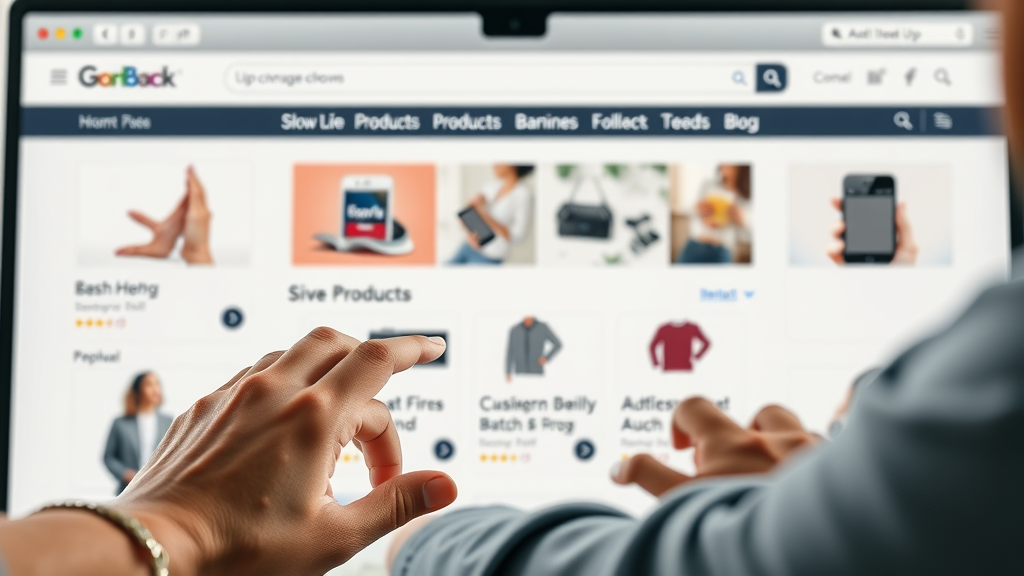Did you know: Companies using real-time content customization see up to 45% higher conversion rates compared to those who don’t? In a world where every second matters, delivering the right message to the right person at the right moment isn’t just a competitive advantage—it’s a necessity. This comprehensive guide will unpack how you can harness real-time content customization to create instant impact , revolutionize your customer experience, and dramatically uplift your marketing ROI. Read on to discover the urgently relevant strategies that can shape the future of your brand!
Shaping the Future: How Real-Time Content Customization Drives Results
- The core concepts behind real-time content customization
- How it revolutionizes the customer experience (CX)
- Tools and strategies for immediate content adaptation
- Measurable benefits for conversion rates and engagement
- Step-by-step implementation for personalized experiences

Understanding Real-Time Content Customization: Meaning and Significance
At its core, real-time content customization is about instantly adjusting website or app content based on live user data—everything from browsing behavior and location to customer profiles and even the time of day. This capacity to react in real time means businesses can present relevant content or personalized product recommendations the moment a customer interacts, increasing both customer satisfaction and loyalty. The significance is massive: instead of static, one-size-fits-all approaches, brands can deliver dynamic, in-the-moment experiences that feel uniquely tailored.
Consumers expect instant gratification and relevance at every turn. Whether browsing on an e-commerce site, scrolling a social media feed, or opening an email, every interaction is a chance to adapt and delight. With real-time content customization, marketers and product teams can move from historical segmentation toward adapting content to current customer actions —this is personalization at the speed of digital life.
For modern brands, the difference between a generic digital experience and one powered by real-time content customization is measurable in both conversion rates and ongoing customer engagement . Investing in this technology isn’t just a trend; it’s a base expectation for businesses that want to remain relevant and competitive in today’s market.
What is Real-Time Customization? (People Also Ask)
Real-time customization refers to the ability of digital platforms or marketing tools to alter content, offers, or experiences immediately based on incoming user data. For example, when a user views a product, the platform analyzes their behavior and instantly suggests related items, updates banners, or changes messaging to align with their interests. This process uses behavioral data, customer data, and often machine learning to optimize the experience on the fly.
This rapid responsiveness ensures users always see the most relevant content , based on what matters most to them in that precise moment. Real-time customization goes far beyond static personalization; it delivers shifting, evolving experiences that match customer intent, increasing the likelihood of driving a desired action.
What is Real-Time Content Creation? (People Also Ask)
Real-time content creation is the process of generating or modifying digital content dynamically as user interactions occur. This could mean updating product recommendations, reshuffling on-site banners, or personalizing email subject lines at the exact second an action takes place. AI-powered platforms, marketing automation, and robust data platforms all play essential roles in making this possible, allowing marketers to craft unique content streams for every visitor.
This form of agility makes marketing efforts drastically more effective, as it aligns perfectly with the user’s current journey, intent, and micro-moment interest. Ultimately, real-time content creation is the engine that keeps experiences fresh, relevant, and irresistibly engaging for customers based on their immediate needs.
What is an Example of Real-Time Personalization? (People Also Ask)
Imagine logging into your favorite e-commerce website. Instantly, the homepage displays promotions targeted to your purchase history and shows personalized product recommendations based on your last visit or items in your wish list. If you add a pair of shoes to your cart, the site immediately suggests matching accessories or creates a personalized offer for expedited shipping. This is real-time personalization in action—serving unique, dynamic content for a truly personalized experience .

What is Content Customization? (People Also Ask)
Content customization is the broader umbrella under which real-time practices live. It includes any approach that adapts website, app, or marketing message content for specific users or audience segments. Unlike real-time content customization, which operates instantly, traditional content customization might rely on pre-set rules or audience types and update less frequently. The end goal for both, however, is clear: deliver the most meaningful, relevant content possible for every visitor to maximize engagement and results.
Effective content customization considers a range of factors—customer data, behavioral data, customer journeys, and more—to build personalized experiences across every touchpoint. Whether real-time or rule-based, the ultimate aim is a seamless, relevant, and customer-centric experience that drives loyalty and action.
Connecting Real-Time Content Customization to Enhanced Customer Experience
Today’s customers expect brands to anticipate their needs and respond instantly. Real-time content customization delivers on this expectation by transforming static digital journeys into dynamic, responsive experiences tailored to each user’s unique path. This immediate adaptation not only increases customer satisfaction but also creates moments of surprise and delight that can build deeper emotional connections.
By aligning content and offers with a person’s individual behaviors, brands provide a level of personalized experience that feels intuitive. The result is not just higher engagement, but more meaningful, memorable interactions—whether online or offline. The customer experience becomes a consistent story, adapting at every turn to keep the user at the center.
Breaking Down the Customer Journey With Real-Time Content Customization
The customer journey is no longer linear. It involves multiple touchpoints across channels like websites, mobile apps, emails, and social media . Real-time content customization is uniquely positioned to add value at each stage—awareness, consideration, decision, and beyond. For instance, a visitor first lands on a homepage, and banners immediately change based on referral source or location. As the customer browses, product recommendations shift to reflect observed user behavior and intent, guiding them toward faster conversion.
In practical terms, each step becomes a chance to reinforce relevance. Example: a returning customer receives a personalized welcome message, while a first-timer sees an introductory offer. When mapped strategically across the customer journey, real-time content customization becomes the secret to delivering stunning customer experiences that turn casual visitors into loyal advocates.

How Customer Data and Behavioral Data Power Personalization
Strong personalization strategies start with customer data and behavioral data . These data types encompass demographics, previous purchases, customer actions , and navigation paths. By tracking and analyzing this information in real time, brands can anticipate customer needs and tailor content accordingly. Modern data platforms integrate these rich insights to create a living, breathing customer profile that continuously evolves as the user interacts.
For instance, if an analytics system detects that a user always reads tech reviews before shopping, it can proactively highlight product comparisons or user-generated reviews. Real-time behavioral data provides immediate feedback loops, ensuring every moment is optimized for engagement and conversion—making personalization feel natural and positively impacting both experience and result.
Strategic Foundations: Building a Data Platform for Real-Time Content Customization
To deliver real-time content customization, brands require a robust data platform capable of ingesting, analyzing, and activating data instantly. These platforms—ranging from customer data platforms (CDPs) to more advanced marketing automation stacks—are the backbone of modern personalization strategies. They centralize customer data from multiple sources, providing a unified view and real-time intelligence for content delivery.
Choosing the right platform is about more than just technology; it’s about ensuring seamless connectivity, scalability, and privacy—all critical for creating frictionless, impactful personalized experiences . A reliable data platform enables brands to move rapidly, testing and refining content based on live user feedback.
Selecting the Right Data Platform for Dynamic Content Delivery
The ideal data platform for real-time content customization should process massive volumes of information instantly, support dynamic content strategies, and offer built-in integrations with websites and marketing tools. Top contenders allow brands to create segmentation based on both historical and real time signals, enabling agility in personalized marketing at any scale.
In evaluating different data platforms, consider their ability to handle privacy, connect with existing infrastructure, and power advanced use-cases such as product recommendations , live A/B experimentation, and omnichannel targeting. When your infrastructure is designed for speed and adaptability, the possibilities for smart, dynamic content are virtually limitless.

Harnessing Machine Learning for Enhanced Personalization
Machine learning is a game-changer for real-time content customization. By analyzing patterns in user behavior and customer data , ML models forecast what content, product recommendation, or message is most likely to resonate at each moment. The technology behind features like personalized recommendations, next-best offers, and dynamic pricing is often a mix of machine learning and rule-based logic driving instant action on the front end.
Adopting machine learning tools reduces manual effort, boosts precision, and ensures even minor behaviors (like a short video watch or quick page scroll) inform the next personalized experience. As these algorithms learn and improve, brands stay ahead—delivering fresh, adaptive content that delights customers while optimizing every marketing dollar spent.
Driving Engagement Through Personalized Marketing and Dynamic Content
Dynamic content isn’t just a buzzword—it’s the pathway to truly effective personalized marketing . By leveraging real-time insights, brands can deliver content that not only captures attention but also sparks customer engagement and inspires action. Personalization makes marketing efforts feel tailored, compelling, and even indispensable to the end user.
This targeted approach extends beyond websites to emails, push notifications, and social media interactions. As touchpoints multiply, so do the opportunities to serve personalized content that guides the customer journey and brings measurable improvements to conversion rates and customer loyalty.
Implementing Personalized Marketing Within Real-Time Content Customization
Effective personalized marketing blends live data, customer profiles, and adaptive messaging. Using marketing automation and robust segmentation, brands can serve not just personalized product recommendations, but also offers, educational resources, or reminders perfectly suited to each shopper’s location, interests, or stage of the funnel. This is personalization in action—driving deeper engagement by showing users you understand and value their needs.
Brands leading the curve combine these tools with smart triggers. For example, a user abandoning a cart receives a message with a personalized offer moments later via email or on-site pop-up, increasing the immediate likelihood of conversion. The more dynamic your approach, the greater the impact on real-time marketing outcomes.
Dynamic Content Tactics for Improved Customer Engagement
Dynamic content strategies put the user at the center of every interaction. This could mean updating web banners based on weather, surfacing products based on region or trending styles, or personalizing blog and editorial content based on previous reading habits. These small, context-aware shifts multiply customer engagement and keep experiences feeling fresh and compelling.
Real-time feedback loops—such as showing customers recently viewed items, or prompting them with reminders on social media —nudge users down the path to purchase while building trust and brand affinity. These tactics are pivotal for brands looking to boost not just engagement but long-term loyalty through thoughtful, personalized marketing initiatives.

Real-Time Content Customization in Action: Use Cases and Proven Examples
What does real-time content customization look like in day-to-day business? It underpins a wide range of proven, high-performing strategies—from live product recommendations on e-commerce platforms, to in-the-moment personalized content on news sites, to algorithmically tailored feeds on social media . These use cases aren’t theoretical; they drive real, measurable business results every day.
Forward-thinking brands now use real-time personalization to shape every part of the customer journey across industries—helping customers discover, engage, and purchase with less friction and greater satisfaction.
Product Recommendations for Individualized Experiences
Intelligent product recommendations are the backbone of e-commerce growth. By leveraging customer data and live browsing patterns, brands can instantly update product carousels and suggestion lists with items most likely to interest each shopper. Whether driven by previous purchases, current browsing, or trending products, these recommendations feel hyper-relevant, nudging customers toward personalized experiences and faster conversions.
Such customization isn’t limited to webshops: retailers, streaming platforms, and content publishers all use similar techniques to ensure their users always see something enticing, based on their unique preferences and prior customer actions .
Enhancing Social Media Interactions With Real-Time Personalization
The fast pace of social media means every moment is an opportunity to connect—and real-time personalization makes those connections powerful. Content feeds are dynamically reordered, ads are targeted to behaviors observed seconds before, and interactive elements (polls, stories, recommendations) shift to match current interests. This adaptability boosts customer engagement and creates one-to-one connections that keep your brand top of mind.
For brands, investing in real-time customization on social media platforms isn’t just about getting attention—it’s about turning impressions into deeper, ongoing relationships through persistent, context-driven content adjustments.

Step-by-Step Implementation Guide: Achieving Effective Real-Time Content Customization
Launching real-time content customization across your brand can seem daunting, but breaking it down into focused, strategic steps makes it manageable and effective. From assessing your customer data to integrating advanced technologies, each phase brings your team closer to seamless, high-impact personalized experiences.
Start with foundational planning, build out technical capabilities, and iterate on results for a continual improvement loop that keeps personalization efforts aligned with your business goals.
Audit Your Customer Data for Quality and Completeness
Before you can deliver personalized experiences , you must ensure your customer data is accurate, complete, and actionable. Conducting a data audit means reviewing all sources of data—CRM, website, app analytics, behavioral data , and more—to confirm accuracy, resolve duplicates, and fill any gaps. Clean, high-quality data lays the groundwork for precision targeting, accurate customer profiles , and effective real-time adjustments.
Brands with robust, trustworthy data can move ahead with confidence—knowing each customer journey is informed by a true, holistic understanding of preferences, behaviors, and purchase intent. Make this audit step an ongoing habit for continuous improvement in personalization strategy over time.

Integrating Data Platforms and Machine Learning Models
The next step is integrating your chosen data platform with advanced machine learning models capable of analyzing live user behavior and automating dynamic content choices. This integration is key to making real-time content customization seamless and scalable. Best-in-class solutions allow for data flow between CRM, CDPs, web analytics, and front-end interfaces—giving marketers full flexibility and instant insight for every campaign or on-site interaction.
Paired with machine learning, your platform can identify patterns, predict next steps, and recommend content or products before customers even ask—delivering the ultimate personalized experience at every step.
Testing, Optimization, and A/B Experiments for Conversion Rates
The most successful real-time content strategies are those continuously refined through testing. Using A/B experiments, brands can trial different headlines, product recommendation algorithms, or message timing, comparing their impact on conversion rates and customer engagement. By optimizing in real time, you rapidly discover what truly resonates with your audience and scale the most profitable tactics.
Make optimization a never-ending process. Track metrics, iterate based on live behavior, and leverage analytics dashboards to surface new opportunities for improvement. This ongoing cycle of testing and learning unlocks the most powerful, enduring results.

Analyzing the Impact: Measurable Outcomes of Real-Time Content Customization
The promise of real-time content customization is validated in industry-leading numbers. From higher conversion rates to measurable jumps in customer engagement and retention, companies with personalization strategies built on live data see major performance lifts versus generic or static digital experiences.
Conversion Rate Increases: Statistics and Industry Benchmarks
Consider these performance boosts: before adopting real-time customization, typical e-commerce brands might see conversion rates below 3%. After implementing dynamic product recommendations and live content strategies, rates frequently jump by 25% to 45% or more. This immediate, quantifiable ROI is a testament to why real-time customization is critical for future-ready businesses.
Below is a comparison showcasing the power of implementation:
| Industry | Pre-Implementation | Post-Implementation | Uplift (%) |
|---|---|---|---|
| Ecommerce | 2.9% | 4.2% | 45 |
| Travel | 3.6% | 5.1% | 42 |
| SaaS | 6.1% | 7.6% | 25 |
Customer Engagement and Retention: Quantifying Benefits
Beyond conversions, customer engagement and retention rates also see dramatic improvement. Repeat visits increase, session times lengthen, and share rates (especially on social media ) often multiply. By continually presenting relevant content and offers, brands create digital environments that customers enjoy—and willingly return to—over and over again, deepening long-term relationships and fueling organic growth.
"Personalization is no longer optional—it’s the engine of modern digital success."
— Leading Martech Analyst

Challenges and Solutions in Real-Time Content Customization Deployment
No innovation comes without hurdles. Brands deploying real-time content customization often encounter challenges around data privacy , technical integration, and content scalability. Recognizing these barriers—and tackling them strategically—separates the best from the rest.
With a structured, collaborative approach, teams can turn these challenges into opportunities for innovation, agility, and even greater customer-centricity across the business.
Addressing Data Privacy and Security
Modern personalization strategies require collecting and using sensitive customer data . Compliance with regulations (like GDPR, CCPA) and strict security measures is non-negotiable. Brands must establish clear policies on data use, deploy secure data platforms, and give users transparency and control over their information. When privacy is prioritized, customer trust—and willingness to engage—skyrockets.
Investing in encrypted data storage, regular audits, and user consent frameworks turns compliance into a competitive advantage for companies serious about impactful real-time customization.
Ensuring Seamless Integration Across Channels
True real-time content customization means unifying the experience across web, mobile, email, and social media . This requires open APIs, smart middleware, and cross-functional teamwork. By aligning marketing, IT, and product development, brands can build robust bridges across platforms—ensuring customers receive consistent, personalized experiences wherever they interact with the brand.
Ongoing integrations and updates are essential for keeping the ecosystem agile and responsive to shifts in user behavior and business goals.
Overcoming Obstacles in Dynamic Content Creation
Scaling dynamic content while preserving brand identity and relevance is a challenge. Creating high-quality, adaptable content that covers multiple scenarios requires a blend of creative vision and technical agility. Investing in modular content frameworks, content automation tools, and strong editorial guidelines ensures that every personalized offer or message remains on-brand—and impactful—no matter how it’s delivered.

Best Practices: Maximizing Results With Real-Time Content Customization
- Prioritize data quality before implementing real-time targeting.
- Train teams in cross-disciplinary skills covering content, customer experience, and data analytics.
- Set clear KPIs for personalized marketing outcomes.
- Embrace iterative testing to drive ongoing improvements.
- Integrate social media with dynamic content for unified engagement.
Watch this in-depth explainer to see how real-time content customization maps to every step of the modern customer journey, boosting engagement and loyalty at each touchpoint.
See live, hands-on examples of real-time product recommendation engines at work—turning browsing sessions into high-converting, personalized experiences for every visitor.
Learn how industry leaders successfully deployed real-time content customization—featuring before-and-after metrics, best practices, and actionable insights to apply in your own strategy.
Frequently Asked Questions About Real-Time Content Customization
-
How can small businesses implement real-time content customization affordably?
Small businesses can start by leveraging budget-friendly tools such as customer data platforms with built-in real-time personalization, integrating plug-and-play recommendation widgets, and using marketing automation features found in many email and CMS platforms. As results grow, businesses can scale these efforts with more advanced solutions over time—making iterative improvements that match both their needs and budget. -
What is the role of artificial intelligence in dynamic content delivery?
Artificial intelligence (AI) enables brands to analyze and respond to user behavior instantly, powering features like personalized recommendations, content curation, and next-best-offer generation. AI continually learns from customer actions, optimizing for higher engagement and conversion without manual human intervention—making dynamic content delivery smarter and more effective. -
Which industries benefit the most from real-time content customization?
While almost every sector can gain value, industries with rapid customer decision-making—such as ecommerce, travel, SaaS, financial services, and media—see the highest returns. These sectors benefit from instant personalization that shortens the path to purchase, increases relevance, and builds deeper, more tailored customer relationships.
Action Steps for Leveraging Real-Time Content Customization
- Conduct a thorough audit of current customer data assets.
- Identify suitable data platforms and machine learning tools.
- Map out customer journeys and set key moments for in-the-moment personalization.
- Launch iterative pilot projects focused on high-impact areas, such as product recommendations or personalized marketing.
- Monitor, measure, and iterate to optimize customer engagement and conversion rates.
The Transformative Power of Real-Time Content Customization for Modern Brands
Ready to turn every customer moment into measurable impact? Take action to implement real-time content customization and watch your customer experience , conversion rates , and brand loyalty soar.
 Add Row
Add Row  Add
Add 





Write A Comment